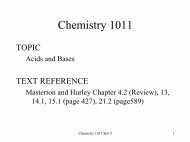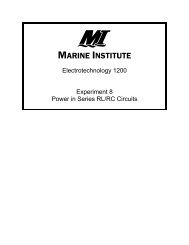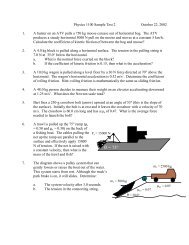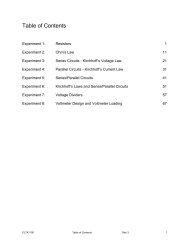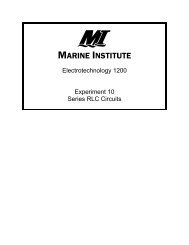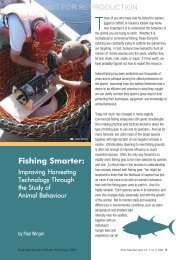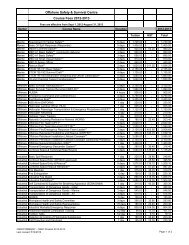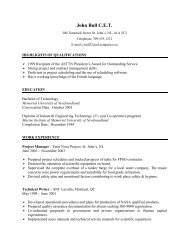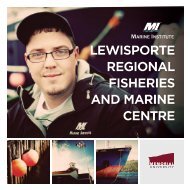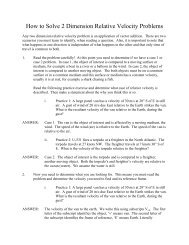Academic Calendar - Fisheries and Marine Institute - Memorial ...
Academic Calendar - Fisheries and Marine Institute - Memorial ...
Academic Calendar - Fisheries and Marine Institute - Memorial ...
You also want an ePaper? Increase the reach of your titles
YUMPU automatically turns print PDFs into web optimized ePapers that Google loves.
DIPLOMA OF TECHNOLOGY - NAVAL ARCHITECTURE<br />
MISSION<br />
The Naval Architecture program is designed to:<br />
• Provide a strong technical education in naval architecture <strong>and</strong><br />
shipbuilding technology.<br />
• Prepare students for employment in shipyards <strong>and</strong> boatyards,<br />
consulting firms, research establishments, government<br />
agencies <strong>and</strong> the offshore oil <strong>and</strong> gas industry.<br />
• Develop practical skills employed in ship <strong>and</strong> boat design, 2D<br />
<strong>and</strong> 3D draughting surveying <strong>and</strong> quality assurance<br />
PROGRAM OVERVIEW<br />
The Naval Architecture program is designed to prepare graduates<br />
to enter the workforce with a sound background in Naval<br />
Architecture technology along with a range of practical skills<br />
ready for use on their first day of employment.<br />
Main Areas of Study:<br />
• In the first year, students begin studying ship types <strong>and</strong><br />
are introduced to the shipping business. Term 2 provides<br />
introductory courses in ship structures <strong>and</strong> marine engineering.<br />
The remaining courses in this year consist of foundation<br />
courses such as mathematics, physics, chemistry, materials<br />
study, <strong>and</strong> communication skills. Practical applications of<br />
commonly used computer software including spreadsheets, 2D<br />
draughting <strong>and</strong> presentation applications are addressed.<br />
• Following Term 2 is a five-week intersession term which sets<br />
the foundation for further study in ship design <strong>and</strong> hull form.<br />
• The second year concentrates on the fundamentals in the<br />
three core subject areas which define a Naval Architecture<br />
Technologist; ship stability, ship structures <strong>and</strong> production, <strong>and</strong><br />
hull strength assessment. Associated with each subject area<br />
is practical skills development including the use of stability<br />
software <strong>and</strong> CAD software for traditional 2D ships’ drawings<br />
as well as 3D design applications.<br />
• Following Term 4 of the second year is a five-week intersession<br />
term concentrating on marine systems <strong>and</strong> the economics of<br />
ship operations.<br />
• The third <strong>and</strong> final year builds on the fundamentals of the three<br />
core subject areas as well as ship resistance <strong>and</strong> propulsion<br />
with each student completing an extensive ship design project<br />
beginning with a mission analysis <strong>and</strong> finishing with a complete<br />
preliminary ship design package. At the same time the student<br />
is introduced to offshore structures <strong>and</strong> composites for boats.<br />
Characteristics of Graduates:<br />
• Successful graduates of the Naval Architecture Technology<br />
program will have a proven work ethic <strong>and</strong> an excellent<br />
underst<strong>and</strong>ing of vessel design <strong>and</strong> construction practices,<br />
preparing them well for initial employment as a Naval Architect<br />
Technologist..<br />
PROGRAM HIGHLIGHTS<br />
• The Naval Architecture program is designed to prepare<br />
graduates to enter the workforce with a sound background<br />
in Naval Architecture technology along with a range<br />
of practical skills ready for use on their first day of<br />
employment.<br />
• Following an introduction to computer aided draughting<br />
in the first year, students hone their skills in the use of<br />
AutoCAD over the next two years through extensive<br />
project work involving ships’ general arrangements,<br />
structural steel drawings <strong>and</strong> a variety of system<br />
schematics.<br />
• The program recognizes the role being played by three<br />
dimensional computer modeling in modern ship design<br />
practice <strong>and</strong> includes training in many of today’s widely<br />
used three dimensional design tools such as Maxsurf <strong>and</strong><br />
Rhinoceros.<br />
• Building on the fundamentals of intact <strong>and</strong> damaged<br />
ship stability, students prepare a st<strong>and</strong>ard Trim <strong>and</strong><br />
Stability booklet as required by Transport Canada for<br />
most registered ships. Software associated with stability<br />
analyses is introduced in the second year with further<br />
exposure, through project work, in the final year of study.<br />
• In the second year the fundamentals of ship resistance<br />
<strong>and</strong> propulsion are studied including the determination of<br />
an appropriate engine <strong>and</strong> propeller for a given hull based<br />
on achieving maximum efficiency. Students will also have<br />
an opportunity to carry out model resistance tests taking<br />
advantage of <strong>Memorial</strong>’s clear water tank testing facility.<br />
The following year, as part of an introductory course in<br />
composite hull construction, students will computer loft<br />
a hull <strong>and</strong> prepare if for cutting on a computer controlled<br />
router, assemble the parts into a plug <strong>and</strong> build a mould<br />
that can be used for creating multiple hull parts.<br />
• The fundamentals of ship resistance <strong>and</strong> propulsion are<br />
studied including the determination of an appropriate<br />
engine <strong>and</strong> propeller for a given hull based on achieving<br />
maximum efficiency. Students will also have an opportunity<br />
to carry out model resistance tests taking advantage of<br />
<strong>Memorial</strong>’s clear water tank testing facility. As part of<br />
an introductory course in composite hull construction,<br />
students will computer loft a hull <strong>and</strong> prepare if for cutting<br />
on a computer controlled router, assemble the parts into<br />
a plug <strong>and</strong> build a mould that can be used for creating<br />
multiple hull parts.<br />
• In the final year of the diploma program each student<br />
undertakes a ship design project for a vessel type of<br />
his own choosing. The project begins in September<br />
with a description of the ship’s mission <strong>and</strong> ends with<br />
a public presentation of the design at the end of May.<br />
A classic approach to the iterative process of ship<br />
design is taken <strong>and</strong> the final design package includes;<br />
computer generated hull lines, general <strong>and</strong> machinery<br />
arrangements, capacity plan <strong>and</strong> structural drawings all<br />
supported by stability analyses, scantling determination<br />
from classification society rules, powering calculations <strong>and</strong><br />
applicable national <strong>and</strong> international st<strong>and</strong>ards.<br />
108



